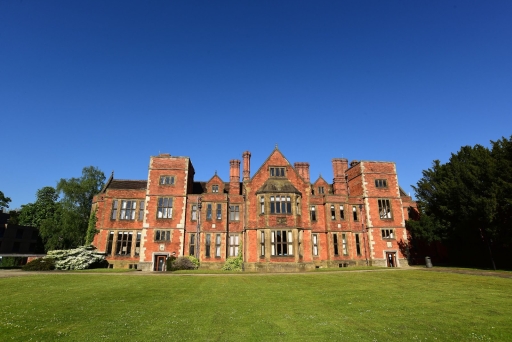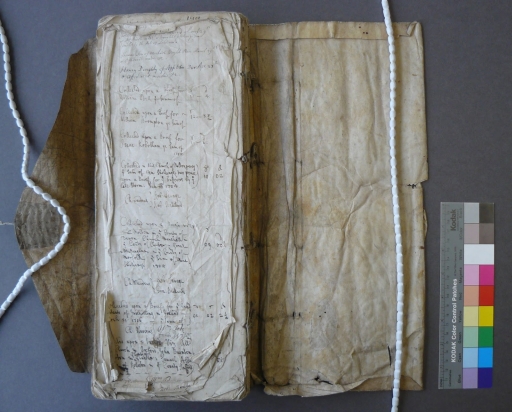Borthwick Newsletter - June 2021
Posted on 26 May 2021
June in the Archives - delve into our catalogues with this month’s featured description
Regulations to be observed on the day of Queen Victoria's Coronation, 20 June 1838 [Musgrave Papers, MUSG/7/3]
What’s New?
As we finally approach the summer we’ve been getting back into the rhythm of things at the Borthwick. The searchroom has been extremely busy through May and is already booked well into June, with many no doubt picking up the threads of pre-lockdown research projects. Our new Access and Engagement Archivist Laura Yeoman joined us in mid-May and we also welcomed Mary Gregson and Lauren Shelton who will be with us for the next nine months. Mary and Lauren will be digitising our parish registers of baptisms, marriages and burials for the online genealogical website Ancestry. Both Mary and Lauren have previously worked in the heritage industry in Yorkshire, and Mary was also a volunteer on our ongoing Yvonne Mitchell Archive cataloguing project.
You will also notice that we’ve been more active than usual on our social media lately, with two new blogs of our own - as well as a fascinating new blog by a researcher using one of our letters from the Yarburgh Muniments. We will be continuing our outreach work in June with an event at the York Festival of Ideas focusing on our Rowntree Archives. On the 15th June, Keeper of Archives Gary Brannan will be chairing a series of short talks on the great potential of the Rowntree family, Trusts and company archives and how they might be used now and in the future. The speakers are Dr Sally-Anne Shearn, Collections Information Archivist; Professor Sue Mendus of the Joseph Rowntree Reform Trust; Dr Kevin Tennent of the York School of Management; and Dr Catherine Oakley of The Rowntree Society. The event will be held online and tickets can be booked for free on the Festival of Ideas website so we hope you’ll join us. You may also spot Gary chairing another talk on York’s City Walls in the Medieval Period by Barry Crump, tickets are available at the website.
New accessions
We accepted a number of additions to existing archives in May. To our parish archives we have added two marriage registers from York, St Hilda, in Tang Hall, covering the period 1979-2020, and burial registers from Upper Poppleton, All Saints, covering the period 1951-2016. We have also received four additions to our Alcoholics Anonymous Archive, including minutes, reports, and magazines for the period 2007-2021. We also added a new volume with an interesting history to our University of York Archive. In 1965 Gwyn A. Williams presented a copy of his Borthwick Paper ‘Rowland Detrosier: A Working Class Infidel, 1800-34’, to the 1963 intake of History students to mark the university’s first year, and we now hold one of those first copies, signed by the author and with a presentation note.
New catalogues
We have a very exciting new addition to Borthcat this month, the catalogue of the University of York Archive. The Borthwick and the University have always had a close relationship, although the Borthwick began life not as a part of the university’s Heslington campus but rather in St Anthony’s Hall in York. The Borthwick was founded in 1953, along with the Institute for Advanced Architectural Studies, to support the application for a university in York by demonstrating that the city could be a centre for academic research. When the university was founded ten years later, the Borthwick was the natural home for its archive and we have continued to look after the university’s records ever since. The archive includes material dating from the early days of the campaign for a university in York in the 1920s, through to the present day. As well as core administrative and teaching records, and personal papers relating to key figures in the university’s history, you can find records of student clubs and societies like the University Women’s Group, the University Radio, and even the Science Fiction and Fantasy Society, as well as a full run of student newspapers.
Number of archival descriptions on Borthcat on 1st June 2021: 81,496
In addition to the University archive we have also added full catalogues for more of our parish record collections, including the parishes of Wighill and Weaverthorpe. Both churches date to at least the twelfth century, and like many medieval churches, both underwent significant restoration in the 19th and 20th century to create the mix of medieval and modern that visitors see today. St Andrew’s, Weaverthorpe, was restored by George Edmund Street in 1872, at the expense of Sir Tatton Sykes of Sledmere Hall, and All Saints, Wighill, was restored in 1912-1913 by W.H. Brierley of York, whose archive can be found at the Borthwick. If you’re interested in church architecture, the Borthwick also holds church faculties as part of the York Diocesan Archive. These record any alterations to church buildings, and when researchers are interested in the physical development of parish churches we often direct them to both the parish archives and the church faculties where they might find plans, sketches, correspondence and other papers that tell the story of how the appearance of the church changed over time. You can read more about church faculties on our website.
News from Conservation
Now that we are able to undertake practical tasks in the workshop again, Catherine has been assessing and documenting some items in preparation for treatment. We document all of our work, to make a record of what we have treated, the condition it arrived with us and any work that is undertaken. Our documentation is both written and photographic, and it forms a really important part of the treatment process. Writing down our observations encourages us to be methodical in our assessment approach, and photographing the items records a lot of extra information that we would not be able to capture in words.
These records have various uses - initially they help us to investigate our treatment options, and come to decisions about how we will treat materials. They also remind us down the line of work that we have done, and how we executed it. Documentation is also a key way to communicate with future conservators and any person who might be looking after the items in the future - if there are any issues they will have a condition assessment at a specific moment in time, as well as a record of exactly what materials and techniques have been used to treat it. It is a very worthwhile product of the conservation process.
Borthwick in the Media
We added two new blogs to the Borthwick Blog in May. Sally-Anne Shearn delved into the letters in our Milnes Coates Archive to tell the story of Lady Mary Arundell and the creation of an Italian convent in the Leicestershire market town of Loughborough in the 1840s. Jumping forward a century, Vicky Taylor used press cuttings to explore the history of the University of York from the beginning of the campaign for a university in the 1940s, to its opening in 1963, and beyond. Vicky researched and wrote the blog as part of her public history placement with the Institute for the Public Understanding of the Past (IPUP) here at the university.
Finally we very much enjoyed a recent blog by Emma Marshall who used a 1700 letter by the elderly gentlewoman Alice Thornton to Henrietta Maria Yarburgh in our Yarburgh Muniments to explore the gifting of medical recipes. ‘The Best That Ever I Had’: Gifting a Medical Recipe in Early Modern Yorkshire’ by Emma Marshall can be read at The Recipes Project, an international research community working on all aspects of recipes through time.
Archive of the Month: Yarburgh Muniments
What is it?
The family and estate papers of the Yarburgh family who owned the Heslington Hall estate from the late seventeenth century to 1956. Their house and lands became the foundation of the University of York and is today known as the Heslington West Campus.
Where can I find it?
You can find the full catalogue for the Yarburgh Muniments on Borthcat.
Why is it Archive of the Month?
It seemed appropriate to make the Yarburgh Muniments June’s Archive of the Month as it has a connection to two of this month’s highlights - the fascinating blog by Emma Marshall that uses a letter from the archive, and the catalogue of the University of York which was founded upon the Yarburgh’s Heslington estate.
Although the connection of the Yarburghs and Heslington began in 1692 with the marriage of Thomas Yarburgh to Anne Hesketh of Heslington Hall, the archive includes deeds dating back to the early 14th century, as well as family correspondence and accounts dating back to the 17th. While the deeds enable us to trace the expansion of the family’s property portfolio in York and beyond, the family papers offer us a glimpse of the Yarburghs themselves - from how they lived to who they knew and the part they played in local and national events. Sir Thomas Yarburgh was Receiver of Rents and Revenues for Queen Catherine of Braganza, the wife of Charles II, and his daughter Henrietta Maria served as Maid of Honour to the Queen. In 1719 Sir Thomas’ granddaughter, another Henrietta Maria, married the architect and dramatist Sir John Vanbrugh. The archive includes Sir Thomas’ accounts for Queen Catherine as well as the ‘Vanbrugh Papers’, a subset of papers and books that include Sir John and Lady Vanbrugh’s account books and letters.

Many of these letters are not listed individually but in groups, giving the determined researcher the opportunity to investigate the full contents for themselves, as Emma Marshall did with the letter of Alice Thornton and her ‘recipe’ for Henrietta Maria Yarburgh. Even those of us who work at the Borthwick still have much to discover about this archive. Only last year Alexandra Medcalf came across a letter to Hesketh Yarburgh in 1740 which made reference to a cargo of 360 enslaved men and women from Barbados. Upon further investigation this letter revealed a connection between the Yarburghs and Captain Saunders of Bristol - who was responsible for some twenty slaving voyages in the 18th century and who featured in Professor David Olusoga’s BBC programme ‘A House Through Time’ in May 2020. No doubt the 111 boxes that make up the archive have yet more to reveal about the history of the Yarburghs and the world in which they lived.
We’ll be back in July with more news and events.


